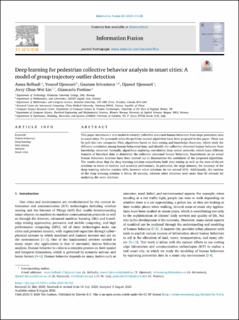Deep learning for pedestrian collective behavior analysis in smart cities: A model of group trajectory outlier detection
| dc.contributor.author | Belhadi, Asma | |
| dc.contributor.author | Djenouri, Youcef | |
| dc.contributor.author | Srivastava, Gautam | |
| dc.contributor.author | Djenouri, Djamel | |
| dc.contributor.author | Lin, Jerry Chun-Wei | |
| dc.contributor.author | Fortino, Giancarlo | |
| dc.date.accessioned | 2021-12-03T09:53:54Z | |
| dc.date.available | 2021-12-03T09:53:54Z | |
| dc.date.created | 2021-04-12T14:05:56Z | |
| dc.date.issued | 2021 | |
| dc.identifier.citation | Information Fusion. 2021, 65 13-20. | en_US |
| dc.identifier.issn | 1566-2535 | |
| dc.identifier.uri | https://hdl.handle.net/11250/2832716 | |
| dc.description.abstract | This paper introduces a new model to identify collective abnormal human behaviors from large pedestrian data in smart cities. To accurately solve the problem, several algorithms have been proposed in this paper. These can be split into two categories. First, algorithms based on data mining and knowledge discovery, which study the different correlation among human behavioral data, and identify the collective abnormal human behavior from knowledge extracted. Secondly, algorithms exploring convolution deep neural networks, which learn different features of historical data to determine the collective abnormal human behaviors. Experiments on an actual human behaviors database have been carried out to demonstrate the usefulness of the proposed algorithms. The results show that the deep learning solution outperforms both data mining as well as the state-of-the-art solutions in terms of runtime and accuracy performance. In particular, for large datasets, the accuracy of the deep learning solution reaches 88%, however other solutions do not exceed 81%. Additionally, the runtime of the deep learning solution is below 50 seconds, whereas other solutions need more than 80 seconds for analyzing the same database. | en_US |
| dc.language.iso | eng | en_US |
| dc.rights | Navngivelse 4.0 Internasjonal | * |
| dc.rights.uri | http://creativecommons.org/licenses/by/4.0/deed.no | * |
| dc.title | Deep learning for pedestrian collective behavior analysis in smart cities: A model of group trajectory outlier detection | en_US |
| dc.type | Peer reviewed | en_US |
| dc.type | Journal article | en_US |
| dc.description.version | publishedVersion | en_US |
| dc.source.pagenumber | 13-20 | en_US |
| dc.source.volume | 65 | en_US |
| dc.source.journal | Information Fusion | en_US |
| dc.identifier.doi | 10.1016/j.inffus.2020.08.003 | |
| dc.identifier.cristin | 1903553 | |
| cristin.ispublished | true | |
| cristin.fulltext | original | |
| cristin.qualitycode | 1 |

